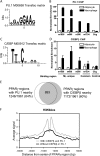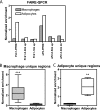Cell-specific determinants of peroxisome proliferator-activated receptor gamma function in adipocytes and macrophages
- PMID: 20176806
- PMCID: PMC2863586
- DOI: 10.1128/MCB.01651-09
Cell-specific determinants of peroxisome proliferator-activated receptor gamma function in adipocytes and macrophages
Abstract
The nuclear receptor peroxisome proliferator activator receptor gamma (PPARgamma) is the target of antidiabetic thiazolidinedione drugs, which improve insulin resistance but have side effects that limit widespread use. PPARgamma is required for adipocyte differentiation, but it is also expressed in other cell types, notably macrophages, where it influences atherosclerosis, insulin resistance, and inflammation. A central question is whether PPARgamma binding in macrophages occurs at genomic locations the same as or different from those in adipocytes. Here, utilizing chromatin immunoprecipitation and high-throughput sequencing (ChIP-seq), we demonstrate that PPARgamma cistromes in mouse adipocytes and macrophages are predominantly cell type specific. In thioglycolate-elicited macrophages, PPARgamma colocalizes with the hematopoietic transcription factor PU.1 in areas of open chromatin and histone acetylation, near a distinct set of immune genes in addition to a number of metabolic genes shared with adipocytes. In adipocytes, the macrophage-unique binding regions are marked with repressive histone modifications, typically associated with local chromatin compaction and gene silencing. PPARgamma, when introduced into preadipocytes, bound only to regions depleted of repressive histone modifications, where it increased DNA accessibility, enhanced histone acetylation, and induced gene expression. Thus, the cell specificity of PPARgamma function is regulated by cell-specific transcription factors, chromatin accessibility, and histone marks. Our data support the existence of an epigenomic hierarchy in which PPARgamma binding to cell-specific sites not marked by repressive marks opens chromatin and leads to local activation marks, including histone acetylation.
Figures







Similar articles
-
Pruning of the adipocyte peroxisome proliferator-activated receptor γ cistrome by hematopoietic master regulator PU.1.Mol Cell Biol. 2013 Aug;33(16):3354-64. doi: 10.1128/MCB.00599-13. Epub 2013 Jun 17. Mol Cell Biol. 2013. PMID: 23775123 Free PMC article.
-
Mechanisms regulating adipocyte expression of resistin.J Biol Chem. 2002 May 31;277(22):19754-61. doi: 10.1074/jbc.M201451200. Epub 2002 Mar 18. J Biol Chem. 2002. PMID: 11901161
-
Tudor-SN, a novel coactivator of peroxisome proliferator-activated receptor γ protein, is essential for adipogenesis.J Biol Chem. 2014 Mar 21;289(12):8364-74. doi: 10.1074/jbc.M113.523456. Epub 2014 Feb 12. J Biol Chem. 2014. PMID: 24523408 Free PMC article.
-
Epigenetic codes of PPARγ in metabolic disease.FEBS Lett. 2011 Jul 7;585(13):2121-8. doi: 10.1016/j.febslet.2011.05.007. Epub 2011 May 19. FEBS Lett. 2011. PMID: 21605560 Free PMC article. Review.
-
PPARγ and the global map of adipogenesis and beyond.Trends Endocrinol Metab. 2014 Jun;25(6):293-302. doi: 10.1016/j.tem.2014.04.001. Epub 2014 Apr 29. Trends Endocrinol Metab. 2014. PMID: 24793638 Free PMC article. Review.
Cited by
-
PPARgamma in Metabolism, Immunity, and Cancer: Unified and Diverse Mechanisms of Action.Front Endocrinol (Lausanne). 2021 Feb 26;12:624112. doi: 10.3389/fendo.2021.624112. eCollection 2021. Front Endocrinol (Lausanne). 2021. PMID: 33716977 Free PMC article. Review.
-
Enhancers: multi-dimensional signal integrators.Transcription. 2011 Sep-Oct;2(5):226-30. doi: 10.4161/trns.2.5.17712. Transcription. 2011. PMID: 22231119 Free PMC article. Review.
-
Acyl-CoA synthetase 1 is induced by Gram-negative bacteria and lipopolysaccharide and is required for phospholipid turnover in stimulated macrophages.J Biol Chem. 2013 Apr 5;288(14):9957-9970. doi: 10.1074/jbc.M113.458372. Epub 2013 Feb 20. J Biol Chem. 2013. PMID: 23426369 Free PMC article.
-
Epigenomic plasticity enables human pancreatic α to β cell reprogramming.J Clin Invest. 2013 Mar;123(3):1275-84. doi: 10.1172/JCI66514. Epub 2013 Feb 22. J Clin Invest. 2013. PMID: 23434589 Free PMC article.
-
Histone deacetylase 3 is an epigenomic brake in macrophage alternative activation.Genes Dev. 2011 Dec 1;25(23):2480-8. doi: 10.1101/gad.175950.111. Genes Dev. 2011. PMID: 22156208 Free PMC article.
References
-
- Barski, A., S. Cuddapah, K. Cui, T. Y. Roh, D. E. Schones, Z. Wang, G. Wei, I. Chepelev, and K. Zhao. 2007. High-resolution profiling of histone methylations in the human genome. Cell 129:823-837. - PubMed
-
- Bouhlel, M. A., B. Derudas, E. Rigamonti, R. Dievart, J. Brozek, S. Haulon, C. Zawadzki, B. Jude, G. Torpier, N. Marx, B. Staels, and G. Chinetti-Gbaguidi. 2007. PPARgamma activation primes human monocytes into alternative M2 macrophages with anti-inflammatory properties. Cell Metab. 6:137-143. - PubMed
Publication types
MeSH terms
Substances
Grants and funding
LinkOut - more resources
Full Text Sources
Other Literature Sources
Molecular Biology Databases
